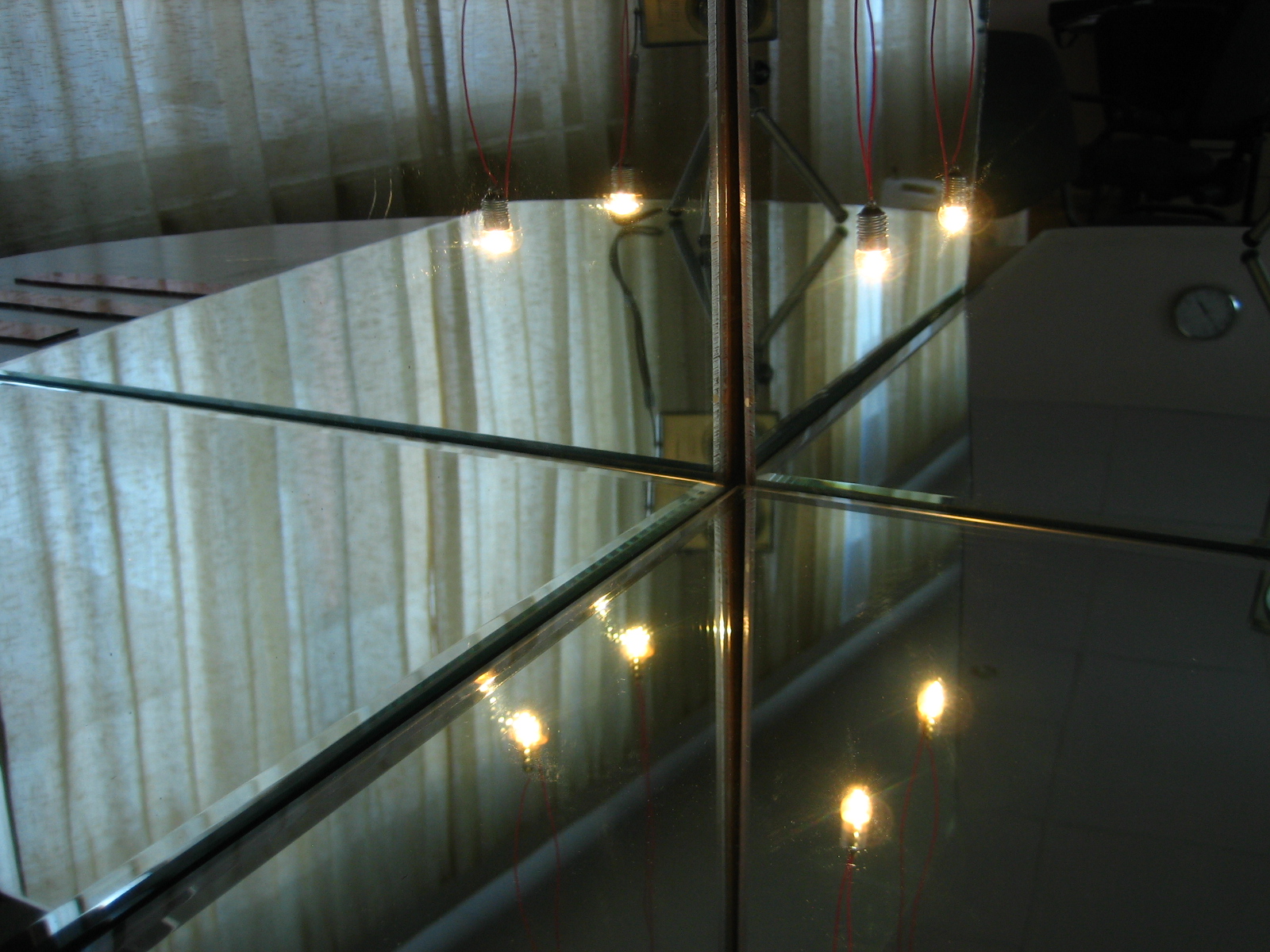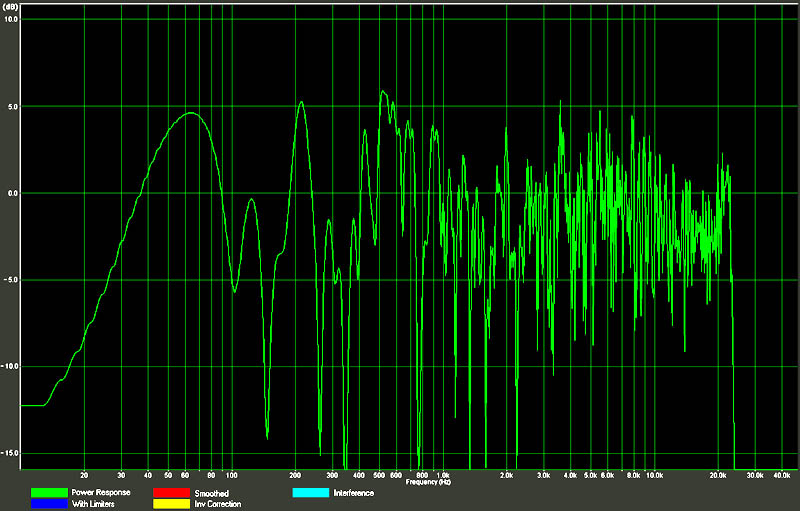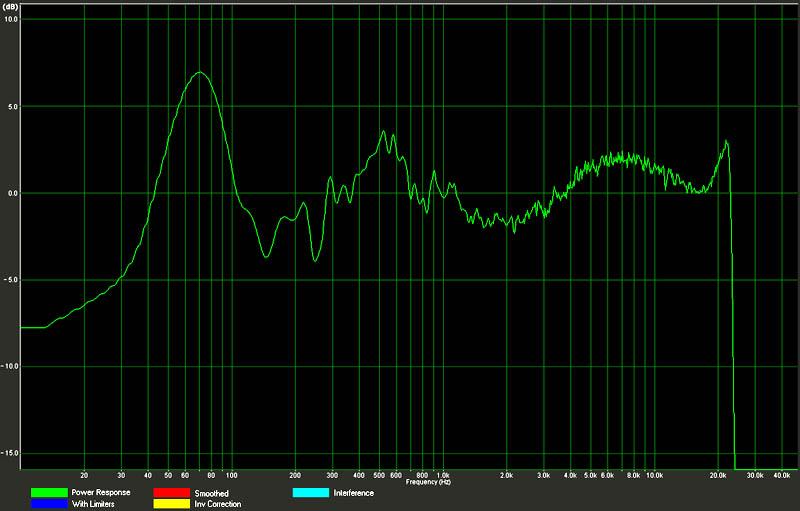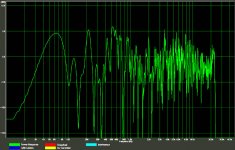If your in room measurements are cluttered with reflections, you have the same problem as does everyone else. In REW, click the "IR Windows" button on the left end of the row above the main screen. A menu pops up. Check the box for "add frequncy dependent windows" set width in cycles to 5 and then click "apply windows" The windowing gates out the reflections. Read the help on that to understand better.🙂
Thank you! 🙂
Oh yes I have read about doing that. Okay I will try right now.
Last edited:
Thanks for posting that!
Oh btw everyone I'm still sorta in the noob phase, Some of this I'm still very much figuring out.
So I tryed making a curve that resembles that one. Sounds pretty good! A lot thicker than what I've been listening to and I don't have to turn it up so loud to hear detail.
So it's starting to make a lot more sence now. it looks like phase is inverse of the responce. On that graph. I took some measurements and the sub already sorta does that. The sub QTC is qtc .5 (I don't have speaker measuring abilities) so I rely on what winisd tells me. But in car response.....no clue...
Well maybe this can be a big learning experience for me....so this is what I've been doing as of lately and maybe y'all can tell me what I'm doing wrong.
( sorry I am not big into screen shots but I can post some of requested)
So.... first I use RTA and make responce flat on each driver with crossovers off
I set my limits 2 oactaves up and down of my target crossover point so I'm not trying to blow up speakers but get a good measurement of the driver. Than I either manually or use auto eq in rew set my output peqs to make driver flat 2 oactaves past it's crossover (s). I generally don't use any boost in peq) Than i take another averaged set of measurements after eq applied and export that into rephase , than I apply my crossovers And make any phase eq adjustments I can with limited taps. Than find by trail and error which rephase option gives me the best predictor. Than I generate a filter and load it into the HDs. One by one speaker by speaker I go through all the speakers and I am using close mic to speakers. (Within 12") . Take a few more measurements and validate the crossover and stop band interference and use peq to turn down the strays. Than I set delays on speakers to match the longest filter. Than I listen and set levels. Than I add delays to closer speakers etc and do some measurements.
At this point I would do listening position gloabal input peqs across all drivers and shape responce.
Only close mic measurements phase makes sence even if I set my t=0 the phase in REw just goes straight down. :/ I can't seem to make it look flat in REw. In REw I can make minimum phase look flat. And it usually hugs the magnitude very close. So this is where I'm a noob . How do you get plain "phase" in REw to not go straight down? I have been under the assumption that I should be looking at minimum phase is that wrong? IIRC if I zoom way way out phase looks more flat. I'm not sure if that's how I should be looking at it though🙁
When I import a listening position measurement into rephase it's clustered with reflections. No matter what I do with acoustic timing it's all over the place. . So I don't know if rephase view mode is phase or minimum phase. So that's why I can't grasp this last part of how to read some of the measurements. I think it's because my room is so reflections.
So when I look at my sub phase for example for it to look like BYRTTs first picture what rew setting is that. Minimum phase?
Thanks for all yalls time and advice.
Yes, it is impossible to talk about some exact phase measurement in a room.
You are doing right by use of very close measurements to tune up your crossover.
And you can evaluate a phase responses only from such very close measurements.
When this is ok, you should turn to the overall performance of your system and look on it from prospective of such optical example
If you will make a RTA measurement you will get something like that.
But it is possible to find a measurement that is emulating our perception of systems behavior
and allow to remove almost any colorations, to allow to tune even different loudspeakers to same reference uncolored sound.
You were mentioning "averaging". It would be interesting to know your source for such idea : ),
but it was offered about 15 years ago, to use the Sound Power Frequency Response that is available from power domain integration (averaging) of sound pressure responses from an area of measurements.
And that allows to get such curve that is ready to use for detailed EQ.
Attachments
skogs, choose the 96kHz sampling rate as intended for the 2x4HD
That worked beautifully, thx! Lower delay per tap as well.
The high and mid in my 3-way is perfectly crossed over with 48db/oct at 1900Hz using 200 taps for the mid and 300 for the high.
Mid to low is currently crossed with 24db/oct at 200Hz using IIR. Any chance of closing in on that with FIR using max 500 taps?
Yes, it is impossible to talk about some exact phase measurement in a room.
You are doing right by use of very close measurements to tune up your crossover.
And you can evaluate a phase responses only from such very close measurements.
When this is ok, you should turn to the overall performance of your system and look on it from prospective of such optical example

If you will make a RTA measurement you will get something like that.

But it is possible to find a measurement that is emulating our perception of systems behavior
and allow to remove almost any colorations, to allow to tune even different loudspeakers to same reference uncolored sound.
You were mentioning "averaging". It would be interesting to know your source for such idea : ),
but it was offered about 15 years ago, to use the Sound Power Frequency Response that is available from power domain integration (averaging) of sound pressure responses from an area of measurements.
And that allows to get such curve that is ready to use for detailed EQ.

Thank you Raimonds! 🙂
Okay so I've been doing it mostly right.
I love the lights in mirror example. That is what I needed to see. I've just been a tad bit uncertain because I see some of these screen shots and mine never look that good. I tryed the 5cy filter on the IR and it worked! Thank you BYRTT!
I definitely have much more confidence in my measurements now.
You guys are the best!
Thank you so much 🙂
What is this sound power integration .
Is it software?
I meant averages by just frequency response averages. Would love to know more about this 🙂
Is it software?
I meant averages by just frequency response averages. Would love to know more about this 🙂
That worked beautifully, thx! Lower delay per tap as well.
The high and mid in my 3-way is perfectly crossed over with 48db/oct at 1900Hz using 200 taps for the mid and 300 for the high.
Mid to low is currently crossed with 24db/oct at 200Hz using IIR. Any chance of closing in on that with FIR using max 500 taps?
Try using filter linearizaton and linearize your IIR crossovers . That will save on taps and should allow you to get all your crossovers made linear
Mark,
You might be able to use the DLNA technology to get it to play from another (Windows installed) JRiver. Worth the test I suppose. The Windows JRiver would have to send the signal to the DLNA device. So if you get JRiver's WMD driver up on that PC it "should" be able to send the signal to the Linux box.
Thanks Ronald, that's the setup I've been using at home...having my Win PC send to ID, via DNLA.
Never tried the WDM driver route with the PC though. Working on that now, to see how it works.
But when I'm not at home, I use the ID as a standalone computer / media source.
So what I *think I want*, to be able to use JR convolution, and to maintain the ability to input external media....
....is a small form PC, be it linux or win, that only has to do three things.
1. accept a stereo AES or spdif coax input,
2. apply JR DSPstudio/convolution, (or any other suitable convolver if not able to flow #1 through JR)
3. connect with a USB soundcard for output to amps ( I already have an 8 ch soundcard that I've verified works with Win...the UMC1820 I was taking measurements with....or for either Win or Linux I can use an x-32 rack which I know works with the Linux ID)
Any hardware recommendations very welcome and greatly appreciated...
(other strategies ditto 🙂
Hey, speaking of the ID and x-32 combo...
The ID is running 8 channels of FIR output. MC says processor is running 6X faster than real time needs.
6 channels @18k taps apiece for speaker management, and 2 @ 256 taps for reference signals. Working / sounding great.
...Hey, speaking of the ID and x-32 combo...
The ID is running 8 channels of FIR output. MC says processor is running 6X faster than real time needs.
6 channels @18k taps apiece for speaker management, and 2 @ 256 taps for reference signals. Working / sounding great.
Working / sounding great is good news 😀 makes one forget the learning curve in long run, and thanks introduce us to ID possibilities.
Thanks BYRTT,
yep, it's sure nice when the learning investment pays off 😀
But you know, I guess we gotta be happy when we learn, even when it's only what doesn't work, huh ? 🙂
yep, it's sure nice when the learning investment pays off 😀
But you know, I guess we gotta be happy when we learn, even when it's only what doesn't work, huh ? 🙂
Can't you do this already with the NUC & UMC1820? Coax/Toslink -> USB -> 8xTRS. And the UMC's lack of OSX driver implies it's UAC2 compliant, so Linux should work.....is a small form PC, be it linux or win, that only has to do three things.
1. accept a stereo AES or spdif coax input,
2. apply JR DSPstudio/convolution, (or any other suitable convolver if not able to flow #1 through JR)
3. connect with a USB soundcard for output to amps ( I already have an 8 ch soundcard that I've verified works with Win...the UMC1820 I was taking measurements with....or for either Win or Linux I can use an x-32 rack which I know works with the Linux ID)
(BTW, I'd appreciate a thread on that box. It offers a lot of I/O for $300, especially with the ADAT option.)
Which CPU do you have again? Does convolution load all cores fairly evenly, or is just 1 running hard?The ID is running 8 channels of FIR output. MC says processor is running 6X faster than real time needs.
6 channels @18k taps apiece for speaker management, and 2 @ 256 taps for reference signals. Working / sounding great.
Every sound source is emitting real power (Watts, Joules per second) that is being absorbed in an environment. And makes it little bit warmer : )What is this sound power integration .
Is it software?
I meant averages by just frequency response averages. Would love to know more about this 🙂
Each loudspeaker has its coefficient of efficiency that is relation between the electrical power submitted to loudspeaker and sound power emitted by it. It is around 4% for best loudspeakers in terms of efficiency.
The 15 years experience is showing that is very good to look on loudspeaker`s power response instead of SPL response in some point, for equalizing decisions.
The Sound Power Frequency Response is better describing the mutual work of 8 loudspeakers (1 real, 7 imaginary) as in mentioned optical example.
Its quality is so high, that it is possible to use it in direct eq filter synthesis just by inverting it.
Please visit "Knowledge base" of aplaudio website and take a look on paper "Equalizing loudspeakers".
It is possible to use software called Workshop to evaluate the sound power frequency response in very accurate and time efficient way. You can get pretty nice result in just 30 seconds measurement - 100 measurement points.
Can't you do this already with the NUC & UMC1820? Coax/Toslink -> USB -> 8xTRS. And the UMC's lack of OSX driver implies it's UAC2 compliant, so Linux should work.
(BTW, I'd appreciate a thread on that box. It offers a lot of I/O for $300, especially with the ADAT option.)
Which CPU do you have again? Does convolution load all cores fairly evenly, or is just 1 running hard?
Hi HammerSandwich, thx for the reply.
I'd love to be able to do the necessary I/O and convolution with the ID, but frankly I'm still very new at how all this works.
So pls bear with a beginner's questions...and my understandings that lead me to ask them...
a. Are you talking about being able to do this all under jriver on the ID ?
b. Or using the ID as a linux box, that also runs jriver?
c. Or using the ID as a linux box, without jriver at all?
a. My understanding is that jriver linux cannot process a live external input, that only windows jriver can, using the WDM driver with 2 soundcards likely being needed. Correct?
b. my understanding here is the way jr set up the ID, it can only be booted into MC. ?
c. i guess this alternative means to get a new ssd and just build a linux box ?
I'd be happy to start a thread on the PC Based forum if that's the right place to take this.... oh, and what do you mean by ADAT option?
I've had the older classic ID's, DN2820FYK, for a couple years. I went to intel's site to look up the processor, a N2830, and see they are at end of life. Stuff moves quick huh?
I don't know how to look at the core loads, because i can't get past MC's bootup loading, to use the box for anything else. Heck, I haven't even been able to put the convolution files directly onto the hard disk...still having to supply them via a USB stick, on device initialization .....
oh, and what do you mean by ADAT option?
I can say this though, the Performance factor as reported by MC, makes it look like number of channels is likely a bigger workload than number of taps.
that umc 1820 looks very interesting . If it works with Linux it could be THE low price solution for room correction, active crossover, and linear phase processing.
Hi 1201,
I hooked the 1820 to the ID yesterday, and verified it handled the 8 channel output from the ID correctly.
I was hoping you would post...I read your multichannel soundcard thread on the PC Based forum..along with posts here..
Can you point me to a guide for building a small form Linux box, hardware and software, that would accept 2 channel analog and digital input, and run multi-channel convolution. There are guides galore for linux media servers, but I'm such a noob I'd prefer a recommendation from someone whose gone down the multichannel convolution path.
And just looking ahead...could such a linux box use the 1820 for both input and output?
Thx. Mark
I hooked the 1820 to the ID yesterday, and verified it handled the 8 channel output from the ID correctly.
I was hoping you would post...I read your multichannel soundcard thread on the PC Based forum..along with posts here..
Can you point me to a guide for building a small form Linux box, hardware and software, that would accept 2 channel analog and digital input, and run multi-channel convolution. There are guides galore for linux media servers, but I'm such a noob I'd prefer a recommendation from someone whose gone down the multichannel convolution path.
And just looking ahead...could such a linux box use the 1820 for both input and output?
Thx. Mark
there is a quite detailed report in https://community.ardour.org/node/13989 on how the umc1820 is under linux
Hi 3ll3d00d, may I of course ask you for a 'how to' guide recommendation too?
I didn't want to ask on the jr forum, as I thought it might lead away from using MC as the convolver...
I didn't want to ask on the jr forum, as I thought it might lead away from using MC as the convolver...
I have found at neat trick to time align the drivers.
In Jriver go to Tools => Advanced tools => Audio Calibration => Start at pink noise test for the number of channels you are using.
Now go to REW => start Real Time Analyser (RTA).
You start so that your speakers have the right polarity ie the sum flat. Now inverse one of your speakers units so that the play in incorrect phase. (You can do it on the fly in Jriver)
Then in Jriver under DSP settings, open a new "delay" and assign some delay to the speakers that needs to be delayed. (ex the tweeter). Then you gradually add delay to that speaker.
In REW you can now see that the negative notch around the crosspoint becomes steeper and stepper. The steepest point is where the speakeres are time-aligned.
In Jriver you can now turn off the reverse polarity, and the speakers should sum flat.
You may need to measure relatively close to start with (1-2 meter). Also take in mind, that between mid and tweeter, small changes in where you place your microphone affects your measurement.
this is also at good source to start with:
https://www.minidsp.com/applications/dsp-basics/time-alignment
To achieve the dips its enough that the drivers are phase aligned which is not the same as time aligned.
//
well it's pretty straightforward if you know linux, if you don't know linux then most of the guide would be learning linux 🙂 perhaps something like daphile might fit the bill? not sure if that accepts audio inputs or not thoughHi 3ll3d00d, may I of course ask you for a 'how to' guide recommendation too?
I didn't want to ask on the jr forum, as I thought it might lead away from using MC as the convolver...
Hi 1201,
I hooked the 1820 to the ID yesterday, and verified it handled the 8 channel output from the ID correctly.
I was hoping you would post...I read your multichannel soundcard thread on the PC Based forum..along with posts here..
Can you point me to a guide for building a small form Linux box, hardware and software, that would accept 2 channel analog and digital input, and run multi-channel convolution. There are guides galore for linux media servers, but I'm such a noob I'd prefer a recommendation from someone whose gone down the multichannel convolution path.
And just looking ahead...could such a linux box use the 1820 for both input and output?
Thx. Mark
I will post a beginners guide tonight 🙂
- Home
- Design & Build
- Software Tools
- rePhase, a loudspeaker phase linearization, EQ and FIR filtering tool


